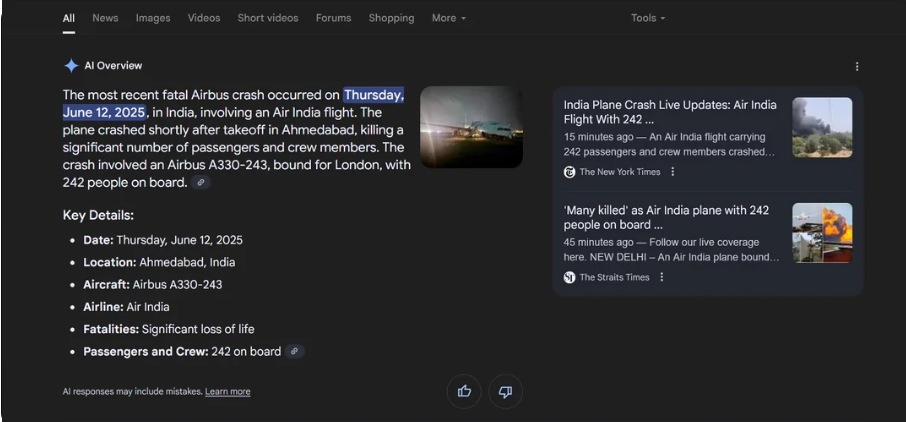
Google AI Mistakes Airbus for Boeing: Why Human Oversight Still Matters
In the hours after the tragic Air India Flight 171 crash, many turned to Google for updates. But Google’s AI Overview presented an incorrect detail — it identified the aircraft as an Airbus A330. In reality, the flight involved a Boeing 787 Dreamliner.
The mistake wasn’t just technical. It appeared in AI-generated summaries shown to users searching for information about plane crashes. Some responses referenced Boeing, others Airbus, and a few even mixed both manufacturers. This confusion highlights a serious issue with AI-generated content.
AI Overviews failed during a moment of crisis
When major events occur, people look for clarity. AI Overviews are designed to summarize answers quickly, but in this case, the summary was wrong. A Reddit user first pointed it out, and similar search results confirmed the inconsistency.
Why did the AI get it wrong? Likely, it encountered articles mentioning both Boeing and Airbus — often in the context of market comparisons — and generated a misleading response. Because generative AI lacks true understanding, it often makes confident predictions without grasping accuracy.
Mistakes from AI can still carry real-world impact
Airbus had no involvement in the crash. Yet due to the AI’s error, the company’s name appeared alongside tragedy-related searches. For Boeing, which continues to face scrutiny over its aircraft, the incident only deepens public confusion.
When misinformation is spread automatically — even without intent — it can affect reputations, mislead users, and impact public trust. The issue isn’t just about accuracy; it’s about responsibility.
The AI sounded sure — but it wasn’t right
Google includes a disclaimer under every AI Overview: “AI answers may include mistakes.” However, it’s subtle, and most users skip over it. The AI’s tone appears confident and factual, which makes these mistakes more concerning.
These kinds of errors, known as hallucinations, are not rare. Generative AI tools are designed to predict likely text — not necessarily truthful content. That’s why, even with impressive capabilities, AI must always be seen as an assistant, not an authority.
Human oversight isn’t optional — it’s essential
This incident is a clear example of why humans still need to guide and monitor AI systems. Algorithms can process vast amounts of data, but only humans can truly interpret context and weigh consequences. Especially in sensitive moments — like reporting on a fatal crash — human judgment cannot be replaced.
While AI may continue improving, it is not yet equipped to handle the weight of public trust on its own. That’s where editors, fact-checkers, and responsible design play a critical role.
Google has now corrected the mistake
After the error gained attention, Google quietly corrected the AI Overview. Updated summaries now correctly identify Boeing as the manufacturer involved in the Air India crash. But the larger issue remains — mistakes like this can happen again.
This moment should serve as a reminder. Until AI can distinguish between pattern and fact, between suggestion and truth, it will need a human in the loop. Not just for accuracy — but for accountability.

